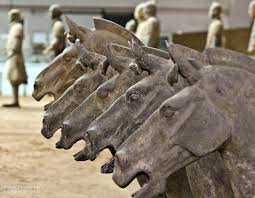
The Terracotta Army: Unearthing an Ancient Wonder
The discovery of the Terracotta Army astounded the world, as there were no historical records of its existence, nor any accounts of an underground army. These life-sized figures lay buried undisturbed for over 2,200 years.
10 Facts About the Terracotta Army
How was the Terracotta Army discovered? What did it originally look like? Discover more about these fascinating figures.
1. A Completely Accidental Discovery
On March 29, 1974, a group of farmers digging a well stumbled upon pottery fragments, leading to the discovery of the Terracotta Army. These fragments prompted the unearthing of the first warrior of the now-famous Terracotta Army. What a remarkable find!
2. No Historical Record of Their Existence
The discovery of the Terracotta Army astonished everyone, as there were no historical records of its existence, nor any accounts of an underground army. These figures lay buried undisturbed for over 2,200 years, which adds to the mystique as it is now the largest and most important tomb site in China.
3. The Sheer Scale of the Discovery is Immense
Since its discovery, over 2,000 terracotta figures of soldiers and horses have been excavated from three different burial pits, with an estimated 6,000 more still buried underground. Perhaps it is the sheer scale of the discovery that adds to its mystery and has captivated the world's attention, leading people to describe the Terracotta Army as the eighth wonder of the world.
4. Amazingly, No Two Figures Are Identical
Incredibly, despite the sheer number of warriors, each one has unique facial features and styling. The different ranks of warriors are buried in battle formation to represent a real army, divided into infantry, archers, generals, cavalry, charioteers, officers and musicians – each with their own individual expressions, clothing and hairstyles.
5. They Are Part of Qin Shi Huang's Quest for Immortality
Qin Shi Huang, the first emperor of China, wanted to live forever. He poured enormous resources into constructing a magnificent underground empire, equipped with everything he would need in the afterlife. He had palaces, an army to protect him, chariots for travel, stables, entertainers, and even his concubines. The mausoleum covers an area of 56 square kilometers, making it the largest burial site in the world. In 1987, it was listed by UNESCO as a World Heritage Site and is a major tourist attraction in Xi'an.
6. It's Not Just Soldiers
Recent discoveries include terracotta acrobats and strongmen. Another pit contains 15 terracotta figures and 13 bronze water birds to entertain the emperor in the afterlife. One pit is filled with stone armor, and several others contain the skeletons of horses. You can see these amazing artifacts at the exhibition.
7. The Dolls Are the Result of Early Mass Production
Government laborers and local craftsmen created the figures in workshops. The terracotta figures are marked with stamps or inscriptions of their creators, including administrators, craftsmen and foremen. Each figure was built from the ground up, using coils of thick clay to form the different body parts, with heads made and fired separately. Sculptural details like hair, facial features, and clothing were added by hand before the figures were dried and eventually placed in massive kilns for firing.
8. The Warriors Were Actually Painted
Originally, the figures were not the earthy color we see today but were painted in bright colors. After firing, each figure was coated with a layer of lacquer before being painted in a variety of vibrant pigments, with colors representing different ranks. In our exhibition, you can see traces of paint on two of the warriors.
9. The Soldiers Carry Real Weapons
Once painted, the figures were arranged in military formation and equipped with real bronze weapons. In the partially excavated pits, over 40,000 weapons have been discovered, including swords, spears, halberds and arrows. Recent research suggests that the weapons were never used in battle, but were instead specifically made for burial with the Terracotta Army.
10. The Biggest Mystery Remains Unsolved: The Tomb of Qin Shi Huang Has Never Been Opened
The exact location of Emperor Qin Shi Huang's tomb remains a mystery to archaeologists and historians as it remains sealed. There have been geophysical surveys of the tomb, but the tomb itself has not been excavated. The Han Dynasty historian Sima Qian wrote about the tomb, describing "palaces for a hundred officials and lodgings for beautiful women," as well as many rare artifacts and treasures. Additionally, the tomb uses mercury to simulate the two main rivers of China, the Yangtze and the Yellow River, and the ceiling of the tomb is decorated with celestial constellations. From here, Qin Shi Huang could continue to rule his empire, even in the afterlife.
Q&A
Q: When was the Terracotta Army discovered?
A: The Terracotta Army was discovered in 1974 by a group of farmers digging a well.
Q: Why was the Terracotta Army built?
A: The Terracotta Army was built to protect the first emperor of China, Qin Shi Huang, in the afterlife.
Q: How many terracotta figures are there in total?
A: It is estimated that there are over 8,000 terracotta figures, with over 2,000 excavated so far.